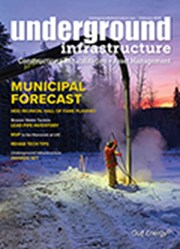June 2012, Vol. 67 No. 6
Editor's Log
Editor's Log: Running, Stumbling To Progress

Traditionally, the June issue of Underground Construction carries a large section focused on various equipment utilized in the underground construction industry. I’m pleased to say this issue is no different.
Our exclusive, comprehensive look at available product lines from the top manufacturers for the underground infrastructure market, meticulously compiled by Managing Editor Traci Read, is available here. Our July issue contains a similar section but that focus is on rehabilitation technologies and equipment.
For our country – and most of the world – the economy struggles to recover from a very deep and prolonged recession. The cynic in me wonders who really cares about new equipment (or even used, for that matter), when the economic future, at least for the near-term, is still suspect? It seems only logical (yes, a Mr. Spock quote – what can I say, I’m an old-school Trekkie), that most contractors and even owners with substantial underground infrastructure equipment fleets, would not be predisposed to purchase much new or used equipment until they believe the economy is on solid ground.
Starting in 2008, the world’s economy began to slip and by the end of 2009 it had completely tanked into the Great Recession, dragging some of the underground construction work to a standstill. Funding for all but essential public works projects went away overnight. Sewer and water projects, the red-headed step child compared to other public infrastructure anyway, suffered crippling blows to already inadequate budgets. It has been well-documented how underfunded and overtaxed our sewer and water systems were before the recession. I estimate the last three years have seen the funding gap between needs and spending more than double.
But when looking outside the underground public works market, the economic dynamic is radically different for the energy and telecommunications markets. In fact, those markets are so strong that skilled labor shortages – even in a recession – are actually inhibiting growth.
The economic wave in the form of shale energy has this country suddenly awash in cheap natural gas and our production of oil reinvigorated to levels not seen in decades. Companies like Valero, the largest independent refiner in the U.S., are cancelling their imported oil contracts and switching over to good ’ole American crude, once some pipeline infrastructure work was completed. Most of the shale production fields are located in remote or challenging terrain, requiring that new gathering and transmission pipelines be constructed. Directional drilling (see our annual HDD update on the 18th) is playing a key role in this market along with track trenchers, excavators, dozers, pipe layers and much more.
Then there is telecom. The lines defining traditional cable companies with telephone companies have virtually all but disappeared. These companies are racing to be information, entertainment and digital business providers. To do that, at long last we’re connecting the dots of users that were bypassed during the rush to build fiber backbone in the late 90s. Work was good before the recession but when the much ballyhooed stimulus billions started hitting the market 18 months ago (after two abortive attempts), an already solid market exploded in several parts of the country. Now, the stimulus funds have about run out, but the market seems on steady enough ground to continue at strong pace. All this continues to bode well for manufacturers of HDD and other types of underground equipment.
Of course, the largest piece of the infrastructure pipe remains sewer and water – public entities. The good news is that funding is not really an obstacle anymore. There are opportunities through a mix of public and private entities to obtain loans. The bad news is that the operative word is “loan,” not “grant.” Cities may be able to get the money, but they don’t have the cash flow yet to pay it back.
Cities now have a better grasp of their funding situation. No longer is their local tax revenue in free fall – rather, it is more of a constant. Municipalities are more comfortable budgeting and spending, albeit at a lower level than three or four years ago.
For now, cities are concentrating on isolated rehabilitation projects rather than larger programs. That has kept many rehab contractors active at a time when their new construction brethren are suffering.
So to answer my original question regarding why would contractors care about an equipment selection guide in this economy? The informed answer is why wouldn’t they? Unlike roads, bridges, airports, etc., the underground infrastructure market is in much better condition. Some sectors are racing along, other areas proceeding very slowly, but the fact remains that most of our market has survived – some aspects even prospered – during this deadly recession. Imagine what we can do with a healthy economy.




Comments